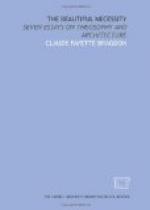It is desirable to have an instant and keen realization of this sex quality, and to make this easier some sort of classification and analysis must be attempted. Those things which are allied to and partake of the nature of time are masculine, and those which are allied to and partake of the nature of space are feminine: as motion, and matter; mind, and body; etc. The English words “masculine” and “feminine” are too intimately associated with the idea of physical sex properly to designate the terms of this polarity. In Japanese philosophy and art (derived from the Chinese) the two are called In and Yo (In, feminine; Yo, masculine); and these little words, being free from the limitations of their English correlatives, will be found convenient, Yo to designate that which is simple, direct, primary, active, positive; and In, that which is complex, indirect, derivative, passive, negative. Things hard, straight, fixed, vertical, are Yo; things soft, curved, horizontal, fluctuating, are In—and so on.
[Illustration 6: WILD CHERRY; MAPLE LEAF]
[Illustration 7: CALLAS IN YO]
In passing it may be said that the superiority of the line, mass, and color composition of Japanese prints and kakemonos to that exhibited in the vastly more pretentious easel pictures of modern Occidental artists—a superiority now generally acknowledged by connoisseurs—is largely due to the conscious following, on the part of the Japanese, of this principle of sex-complementaries.
Nowhere are In and Yo more simply and adequately imaged than in the vegetable kingdom. The trunk of a tree is Yo, its foliage, In; and in each stem and leaf the two are repeated. A calla, consisting of a single straight and rigid spadix embraced by a soft and tenderly curved spathe, affords an almost perfect expression of the characteristic differences between Yo and In and their reciprocal relation to each other. The two are not often combined in such simplicity and perfection in a single form. The straight, vertical reeds which so often grow in still, shallow water, find their complement in the curved lily-pads which lie horizontally on its surface. Trees such as pine and hemlock, which are excurrent—those in which the branches start successively (i.e., after the manner of time) from a straight and vertical central stem—are Yo; trees such as the elm and willow, which are deliquescent—those in which the trunk dissolves as it were simultaneously (after the manner of space) into its branches—are




